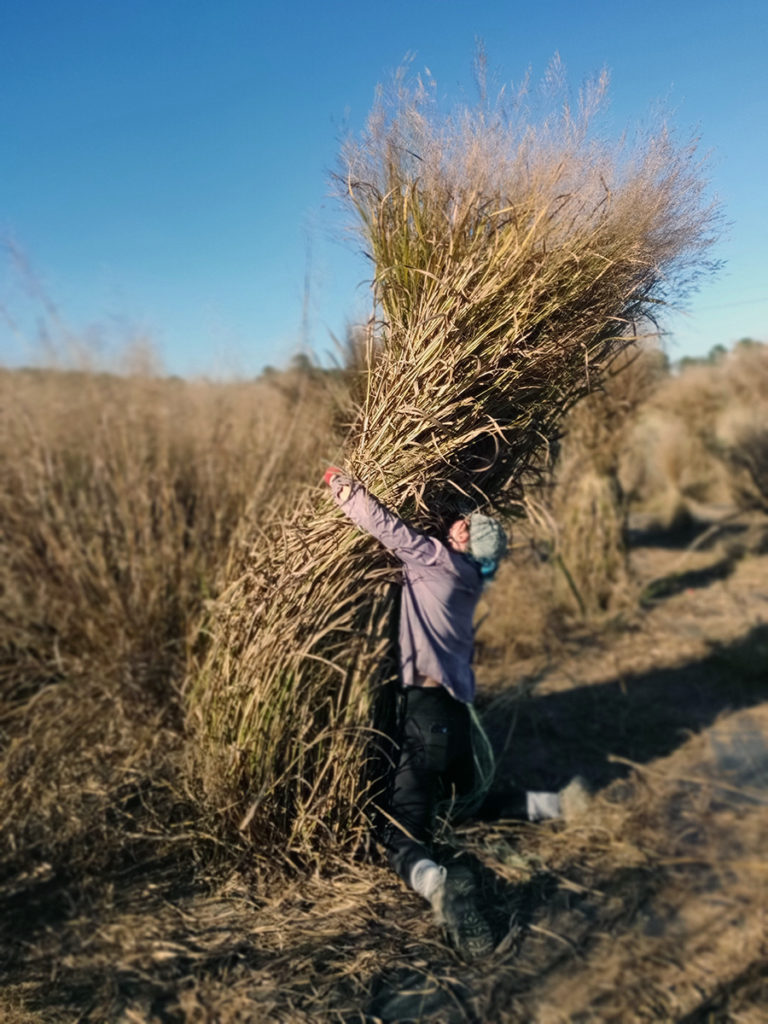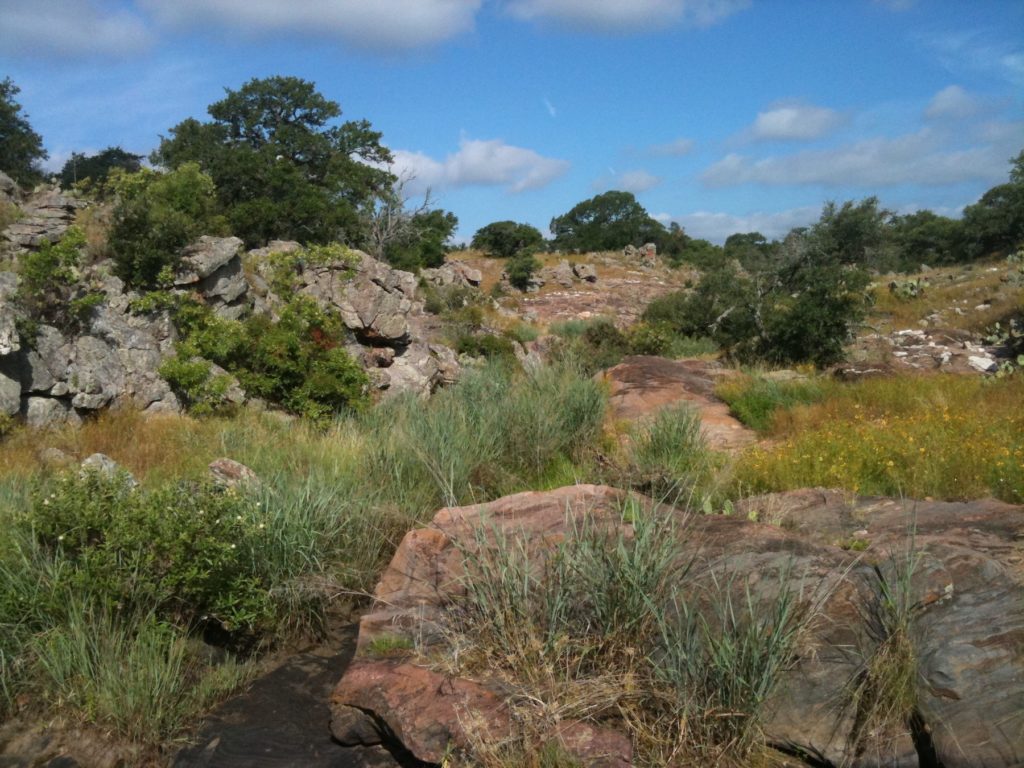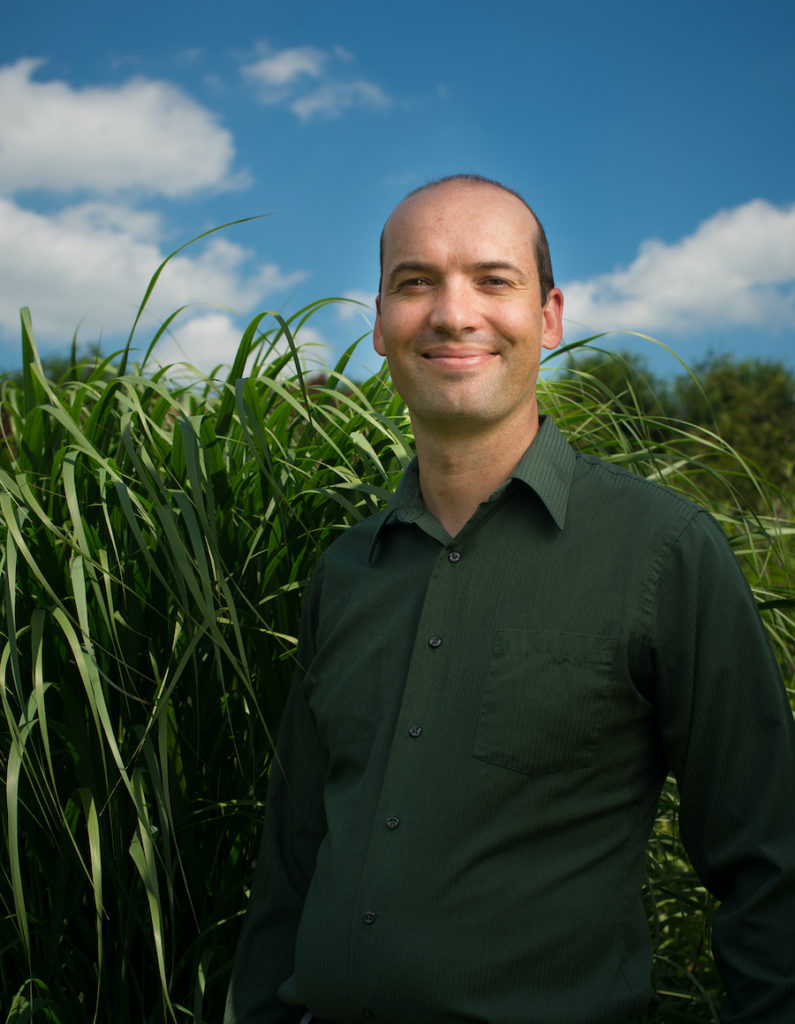A tall native plant of the North American prairie, switchgrass (Panicum virgatum) has long been a tantalizing potential biofuel feedstock. But switchgrass has a complex genome and, as a species, encompasses dizzying diversity. So, a team of scientists made an ambitious plan to begin to link the plant’s varying traits — height, biomass, hardiness to cold, etc. — to its genes. The undertaking took shovels, trucks — and more than a decade.
With the results just published in the journal Nature, listen to the episode for a romp through their switchgrass story.
The Joint Genome Institute presents the Genome Insider podcast.
Transcript of the episode
ALISON: Hey! I’m Alison Takemura, and this is Genome Insider, a podcast of the US Department of Energy Joint Genome Institute, or JGI. This episode is all about one of the tall grasses of the American prairie: switchgrass.
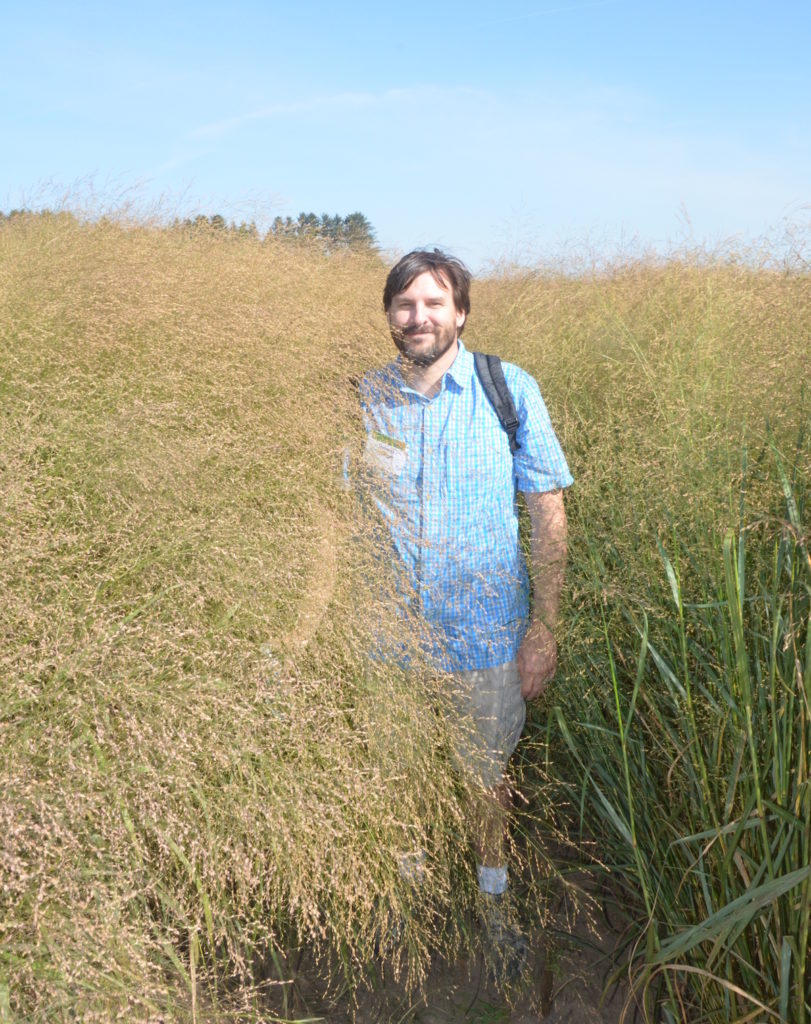
Biologist Tom Juenger hides in a switchgrass stand at an annual switchgrass meeting in Madison Wisconsin. (Jeremy Schmutz)
TOM: You stand next to them and you feel lost in a sea of grass.
ALISON: That’s Tom Juenger, a biologist at the University of Texas at Austin.
DAVID: Yeah, I’m six-foot-four, and I can’t see past them.
ALISON: And that’s David Lowry, a plant biologist at Michigan State University.
DAVID: And sometimes down in Texas, I, I think that they got up to about 15 feet tall, but they fall over once they get that tall.
ALISON: And that’s just in one year. They don’t always grow that tall, but it’s pretty amazing right?
ALISON: Tom and David work on switchgrass, a plant native to North America that’s found in different regions across the US: from the east coast to the Rocky Mountains, from Canada down into southern Mexico. Switchgrass is also a Department of Energy flagship bioenergy crop, because it’s a tantalizing resource for biofuel. Besides being able to grow so huge and so fast, it’s pretty drought-tolerant, and it doesn’t need fertile agricultural soil, but instead it can grow on marginal land. It’s also a long-lived perennial plant.
DAVID: It all comes back from the base every year and grows to, to about six or seven feet. And then every fall we harvest them.
ALISON: Harvesting the growth above ground mimics what’s been happening in North America for millennia.
TOM: In natural populations, what would often happen, certainly in the prairie habitats is they might burn. So the material would burn off every year or every couple of years. And then there’d be reestablishment from below-ground plant parts. Certainly some areas probably would have received lots of grazing by bison, and native herbivores. And so some of that plant material will be removed and regrow every year.
ALISON: I love hearing about the ebb and flow of natural systems in North America, especially before they were decimated by Western colonization. The sad fact is that we only have about 1% of North American tall grass prairies left. But, switchgrass — this holdout of the past — could be a key part of our energy future.
ALISON: Let me tell you about one of the really important things about switchgrass. There are regional differences among switchgrass populations. Even though they’re all the same species, which is called Panicum virgatum, switchgrass is made up of different populations with different attributes.
DAVID: One of the things that we’ve observed is that the plants from the northern United States are often smaller in size, we don’t get as much biomass yield out of them. But the plants from the southern US are these, what we call large lowland plants, and they get much larger.
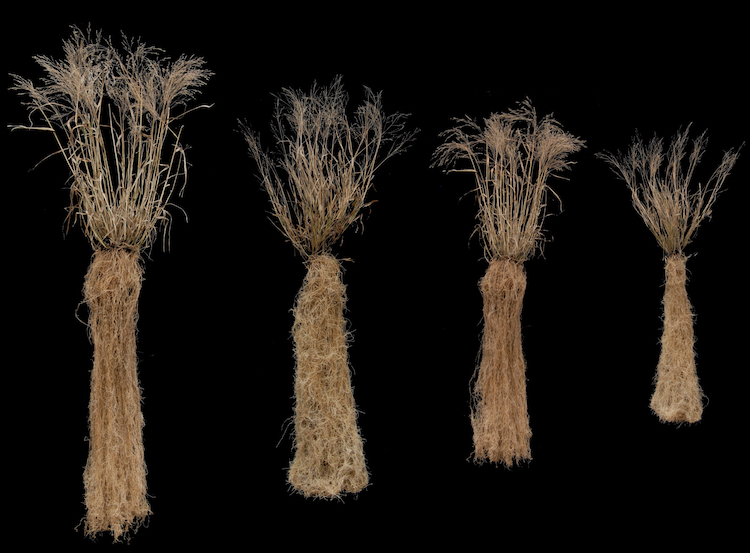
Switchgrass grows profusely above and below ground, but the lowland type tends to be larger than the upland type. This is a photo of shoot and root biomass from lowland (left two) and upland (right two) switchgrass individuals. These plants were from a single growing season. (Jason Bonnette)
But their Achilles heel is that they often-times get killed by winter conditions in the north. And so one of the strategies going forward and that breeders have taken and that we’d like to participate in, is to actually be able to get these Southern lowland ones to get a higher level of cold tolerance so that they can survive the winters. And so we can get both high yield, as well as cold tolerance and survival.
ALISON: David and Tom want to carefully map out these kinds of local switchgrass adaptations, and link these traits to their underlying genetics. It’s a whopper of an undertaking, though, so I’m going to walk you through it. The idea is to collect a whole bunch of switchgrass plants from around the US, to try to capture some of their huge genetic diversity. And then the next step, is to split up those plants into genetically identical copies.
TOM: With switchgrass, we can take a single individual and chop it up into small rhizome pieces and plant those identical copies in many locations.
ALISON: These locations would end up being 10 different research gardens spread out across different regions and climates of the US. Scientists would see how the plants would do in those different places and collect that data. And at the same time, scientists would be getting the individual plants’ genomes sequenced. Then, they would be able to correlate the plants’ physical or phenotype data with their genetic data.
So, this is like studying twins that are separated at birth. With human twins, if they grow up in different places, maybe their environments make them different. Maybe some become more prone to allergies, or others get taller than their twins do. Well, how about plants? How do different environments affect plants that are genetically identical?
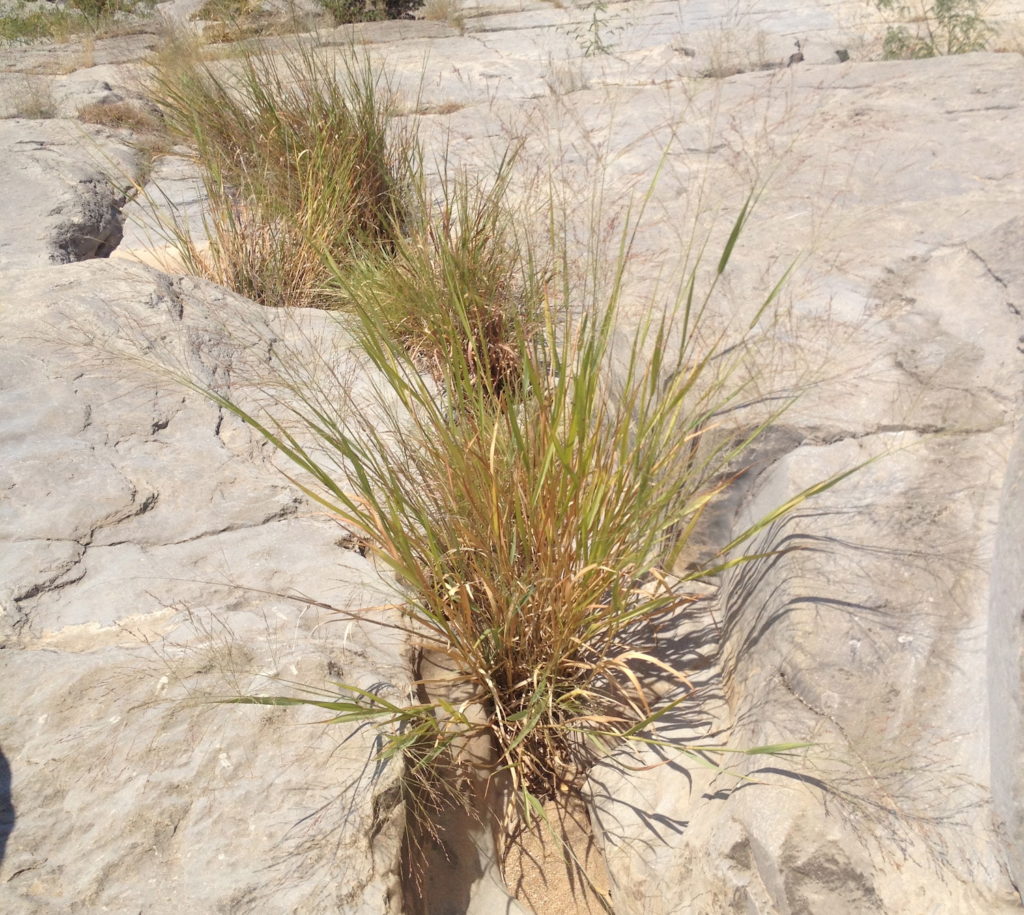
Switchgrass creeps up in cracks of rock at the arid Devils River State Recreation Area in Texas. (David Lowry)
TOM: We’re in this unique situation with plants, where we can clonally propagate them, effectively making as many twins as we want. And we can take those twins, and we can plant them in many, many different environments, and really look at how similar they are across locations, or how different they are across locations. You know, how important the genes are, how important the environment is, or really how, and perhaps most interestingly, how those things interact in complex ways.
ALISON: Now, what was the first step to actually doing the experiment? Tom and David had to get their hands dirty. So, they started collecting plants from all over.
DAVID: Originally, a lot of these collections came from us driving around in a truck with a shovel and digging up plants off the side of the road, or parks where we had permits, and collecting them together. In, essentially, like a huge area outside of these greenhouses in, in Austin, Texas, where they sat in gallon pots on many, many tables and took up a huge amount of space. And so Tom sort of turned into a production nursery in a way. And then people divided these plants, meaning that they ripped them apart, and made multiple copies of them. So, 10 different copies of them.
ALISON: Then, of course, the switchgrass plants had to be shipped to the other gardens around the country: three others in Texas in addition to the one at Tom’s home institution at UT Austin, one garden in Oklahoma, one in Missouri, one in Nebraska, one in South Dakota, one in Illinois, and one in Michigan.
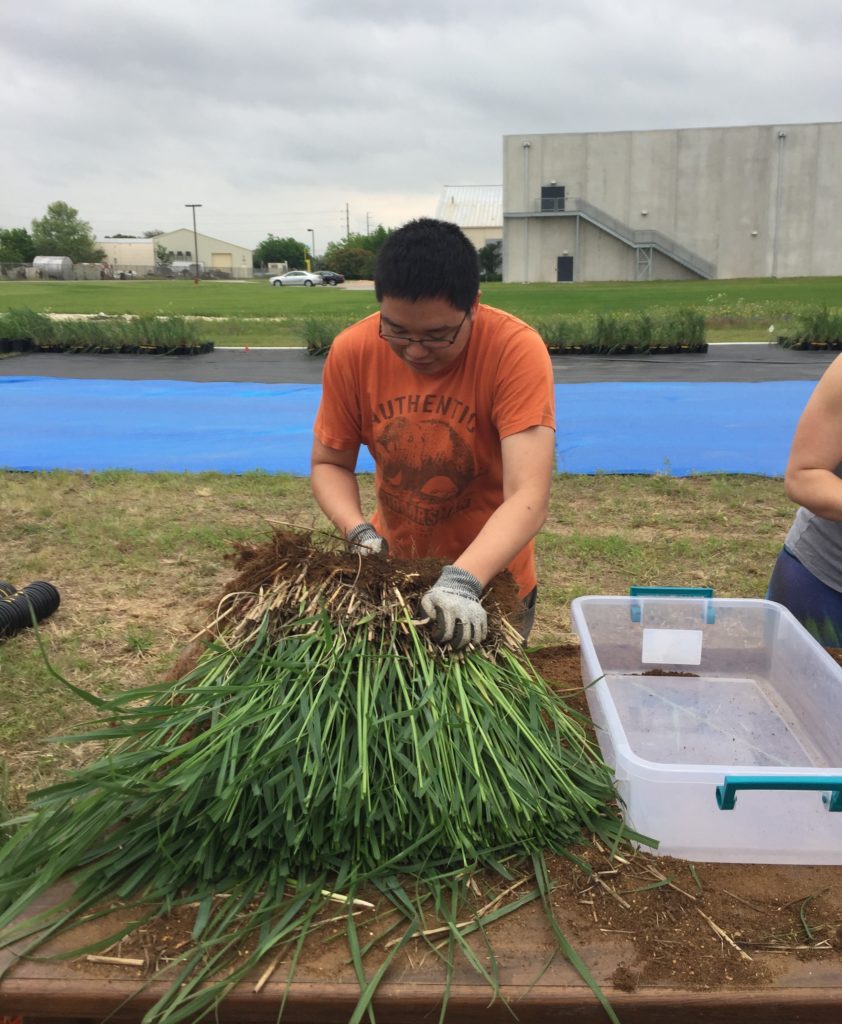
The Juenger lab divided and propagated switchgrass for the nursery, so that switchgrass clones could be shared with research gardens in multiple states. (Tom Juenger)
DAVID: And so, there was this massive amount of pots that then were put into semi-trucks and taken all the way up through from Texas through the middle of the country and dropped off at different places, and then planted into the ground at each of those locations.
So, it was a massive undertaking that took a huge amount of time to get all this material together and put it out there. And that was the, the foundation of the experiment. But it’s in no way trivial to do that.
ALISON: But David explains that that effort has a long-term payoff.
DAVID: So, by having 500 or more different clones out there in the field, you can then conduct what’s called a genome-wide association study, to identify the different regions of the genome that contribute to adaptation across the continent of North America.
ALISON: One of those adaptations is simply whether or not plants survive.
DAVID: So for example, when we take plants from the northern United States and plant them in the southern United States, a lot of them get killed off during the summertime, because it’s so hot, and they’re not able to tolerate that higher temperature and high level of drought. And then in the north, a lot of the plants can’t survive over the winter. And so we see, we see them all senescing in the fall, going dormant. But then a lot of them don’t reemerge in springtime, and, and we infer that they’ve been killed off during the wintertime.
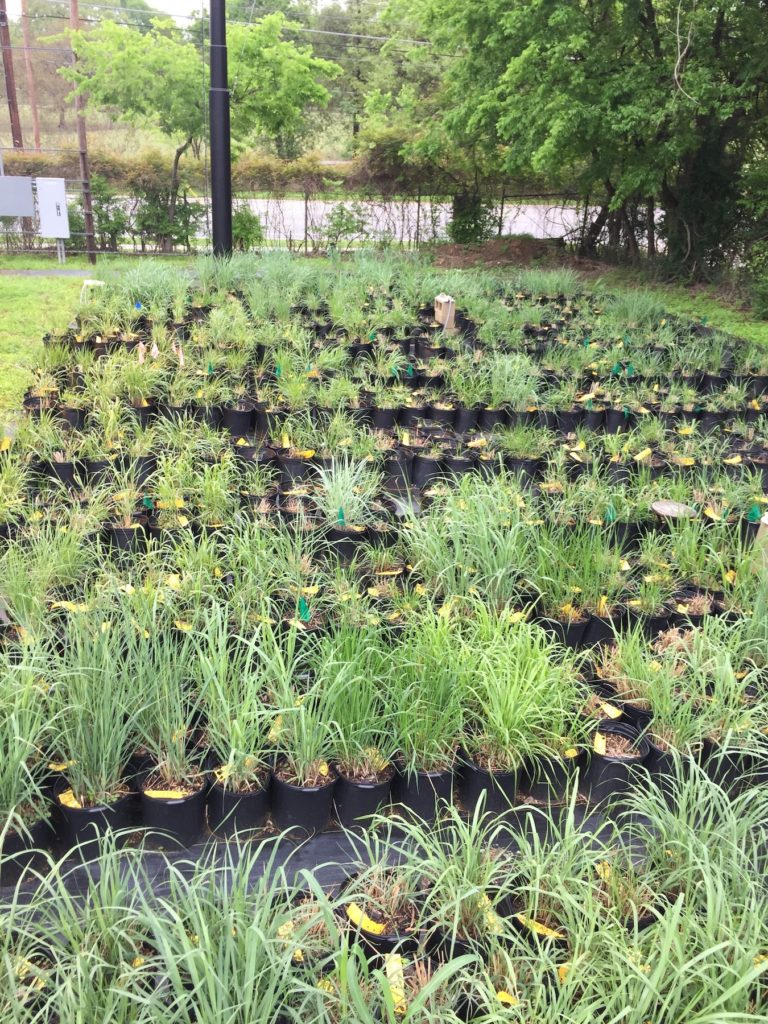
The switchgrass diversity nursery at the University of Texas at Austin Brackenridge Field Lab. (Tom Juenger)
And those ones that die are often the ones from the southern United States. And in this study, we were actually able to find some of the genomic regions that contribute to those adaptations of those northern ones to be able to actually survive winter.
ALISON: In other words, this result was one way in which their experiment was a success. Tom, David, and their team were able to discover regions, or loci, of the switchgrass genome that help the plant to adapt to cold winters.
DAVID: But it also tells us those are loci that we might want to focus on and select upon to create a switchgrass that is resilient to winter, that can have a high yield and also be a plant that persists for many years.
ALISON: The team of researchers actually found a natural example of a group of switchgrass adapting to a colder climate. This very special bunch was a population of plants from the northeastern United States.
DAVID: And they look a lot like the plants from the Midwest. We classify them as these upland ecotypes. They have similar morphological traits to each other. But when we looked at the genomic data that came back, it turned out that they really were more closely related to all the other plants along the Atlantic seaboard. And so we were left with this mystery of what was going on here. How are these plants that look like the Midwestern ones up in the northeast? And why were they more related to the ones from the.. along the Atlantic coast? And it turned out, there was some mixing that happened in the past between the ones from the Atlantic coast and from the Midwest. And through that, they also gained potentially cold tolerance and ability to survive winter.
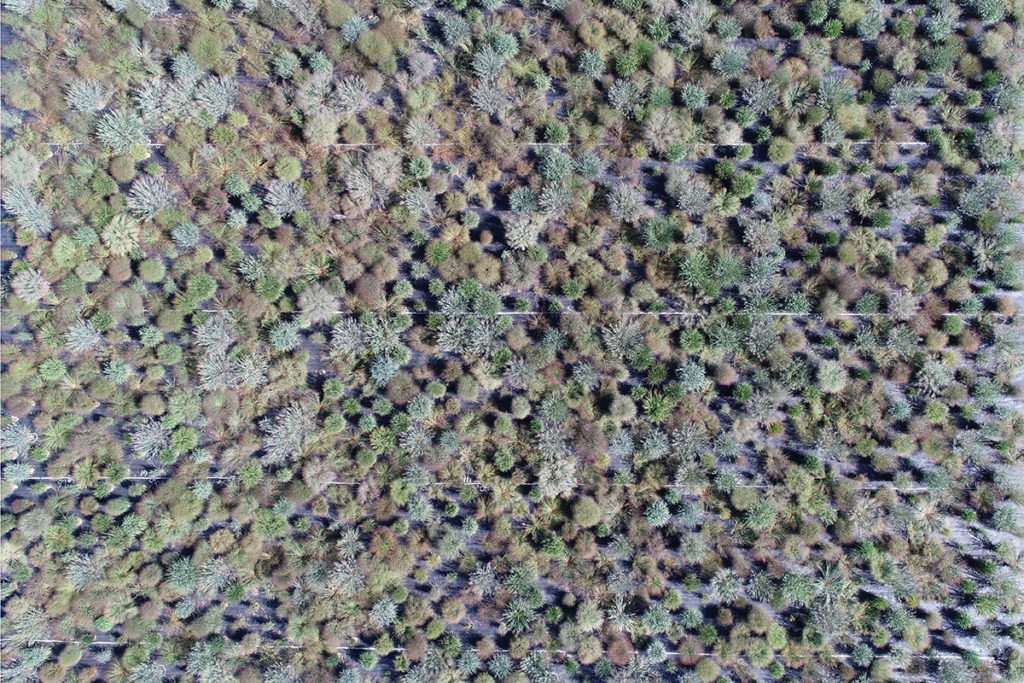
Seen from above, the switchgrass diversity collection late in the 2020 season at the Kellogg Biological Station in Michigan. (Robert Goodwin)
ALISON: So, that’s what David and Tom and their team think happened. That there was some rare interbreeding between the switchgrass populations, thus giving the Atlantic population the power to withstand colder winters.
DAVID: Another really good classic example of this is, you know, the snowshoe hare that turns white in the wintertime. There’s populations of the snowshoe hare in the western United States, in Washington state where there’s not snow. And those hares don’t turn white in the wintertime, they actually stay brown. And it turns out that the reason why they stay brown is that they received a region of their genome from rare crossing events with jackrabbits.
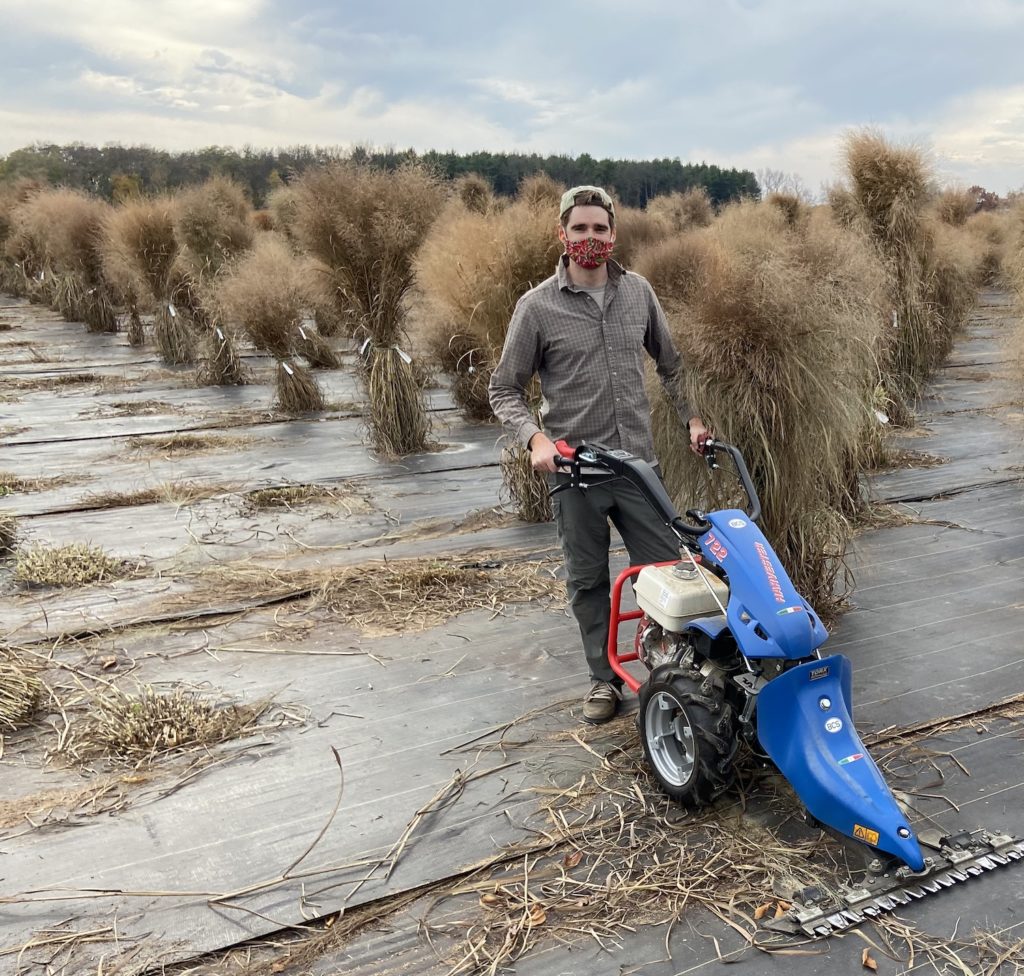
Harvesting the switchgrass collection, or diversity panel — this one growing at the Kellogg Biological Station in Michigan. (David Lowry)
ALISON: A piece of the jackrabbit genome got into the snowshoe hare and allowed it to adapt to a place that doesn’t have snow in the wintertime. It’s an amazing analogous story to what happened with the switchgrass populations. The Atlantic coast switchgrass also got some good genes that helped them better adapt to their environment.
To pinpoint these and other helpful regions of the genome, the JGI and the HudsonAlpha Institute for Biotechnology, which is a DOE-funded partner institution, sequenced more than 700 individual plants of switchgrass that the team had collected for their gardens. But these genome sequences were rough, approximate. Pieces of the puzzle, but not the complete picture. So, the team also worked at developing a well-resolved reference genome of switchgrass. It would be the one genome to rule them all, and fill in the gaps for the other sequences.
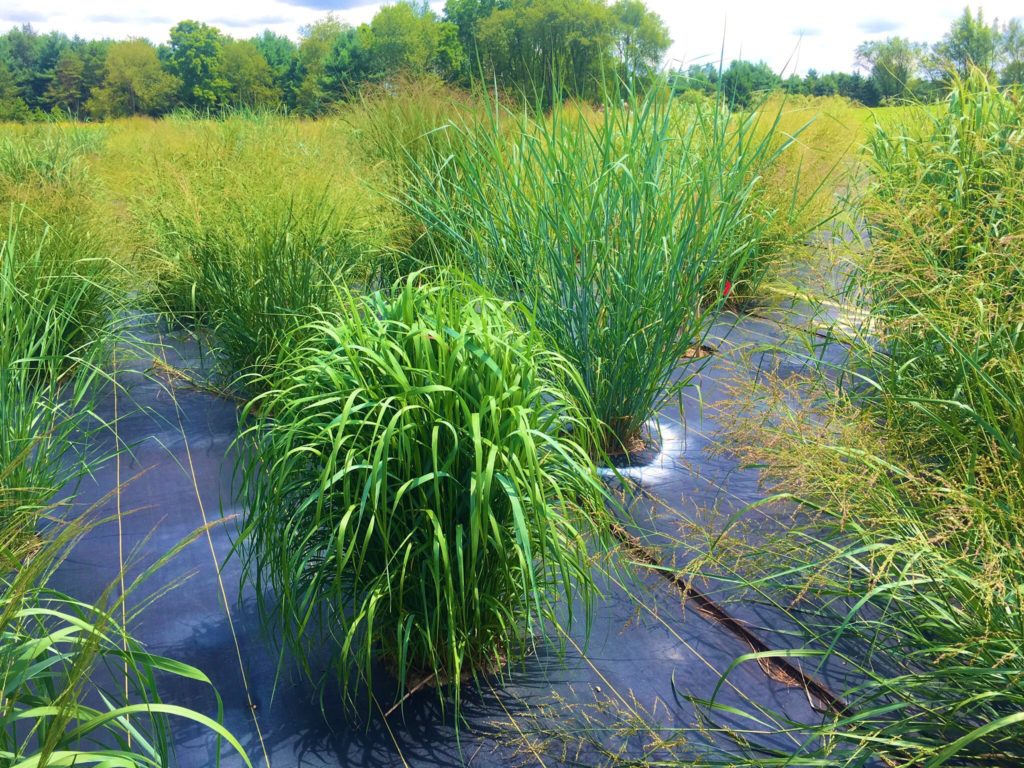
The switchgrass diversity panel growing at the Kellogg Biological Station in Michigan. (David Lowry)
But getting a really complete version of the switchgrass genome took a really long time: 10 years. It’s understandable, though: Plant genomes are gnarly. They often have multiple copies of chromosomes. The switchgrass in this project has nine chromosomes, and four copies of each of those nine. And so, putting a genome together actually becomes really hard. The switchgrass team had made previous versions of a reference genome, but because sequencing technology has advanced so much since they started, this version, the fifth version, is a big leap forward.
DAVID: It’s been kind of amazing to watch through this whole process, as we’ve gone through from version one to two to three to four to five. And we keep thinking, Okay, this is the version we’re going to stick and work with. And then the technology changes, and ‘Wow, this is so much better.’
But it does seem like this new version of the genome is just amazing in terms of how complete it is.
ALISON: This version of the genome sequence is a much clearer map than what they’ve had in the past. With the last version of the genome, version 4, they couldn’t resolve regions of interest, like what genes
might be involved in cold tolerance. With this version, scientists can spot those regions, and breeders can use them to develop new strains of switchgrass.
ALISON: The DOE, in addition to having national labs and user facilities like the JGI, also has Bioenergy Research Centers, and they helped to support this work. David, for example, is part of the Great Lakes Bioenergy Research Center. Now, all of these centers still get to benefit from those 10 farflung switchgrass research gardens: the gardens are still alive, and they’re ripe for collecting more data.
DAVID: I think going forward, something that’s exciting, that a lot of the bioenergy centers are interested in, is using drones and other types of aircraft and remote sensing to look at these plants throughout the season, see how they change, and be able to utilize that in combination with the genomics. And then maybe bring in some artificial intelligence and machine learning to make some predictions based on that.
And so I think that’s the, what I see is the future going forward. And hopefully we’ll be able to take advantage of that new technology.

John Lovell, evolutionary biologist at HudsonAlpha Institute for Biotechnology. (Courtesy of John Lovell)
ALISON: The ins and outs of the switchgrass genome and its diversity were just published online for the February issue of the scientific journal Nature. The paper encapsulates a long-term labor of love for dozens of researchers including Tom, David, JGI Plant Program head Jeremy Schmutz, and the paper’s first author, John Lovell, a JGI-supported evolutionary biologist at HudsonAlpha. For the link to the paper, see the show notes on our website.
ALISON: This episode was directed and produced by me, Alison Takemura, with editorial and technical assistance from Massie Ballon and David Gilbert.
Genome Insider is a production of the Joint Genome Institute, a user facility of the US Department of Energy Office of Science. The JGI is located at Lawrence Berkeley National Lab in beautiful Berkeley, California.
A huge thanks to Tom Juenger of the University of Texas at Austin, David Lowry of Michigan State University, JGI Plant Program Head Jeremy Schmutz, and JGI-supported biologist John Lovell for sharing their research and making me enamored of switchgrass.
If you want to look at or harness the data that they and their team generated, you can find it at JGI’s public repository, Phytozome: the JGI’s online comparative genomics platform for plants.
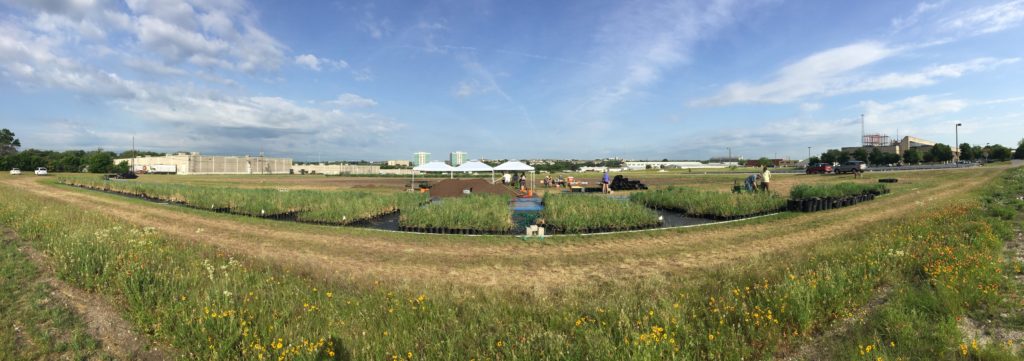
Hundreds of unique switchgrass plants were propagated for distribution to other research gardens at the UT Austin Pickle Research Campus. (Tom Juenger)
If you enjoyed Genome Insider and want to help others find us, leave us a review on Apple Podcasts, Google Podcasts, or wherever you get your podcasts. If you have a question or want to give us feedback, Tweet us @JGI, or record a voice memo and email us at JGI dash comms at L-B-L.gov. That’s jgi dash c-o-m-m-s at l-b-l dot g-o-v.
And because we’re a user facility, if you’re interested in partnering with us, we want to hear from you! We have projects in genome sequencing, synthesis, transcriptomics, metabolomics, and natural products in plants, fungi, algae, and microorganisms. If you want to collaborate, let us know!
Find out more at jgi.doe.gov forward slash user dash programs.
And if you’re interested in hearing about cutting-edge research in secondary metabolites, also known as natural products, then check out JGI’s other podcast, Natural Prodcast. It’s hosted by Dan Udwary and me. That’s it for now. See ya next time!
Additional information related to the episode
- News release: Fields of Breeders’ Dreams: A Team Effort Toward Targeted Crop Improvements
- Switchgrass genome v5.1 on JGI Plant Portal Phytozome
- Science Highlight: Developing Switchgrass for Biomass Production
- JGI Plant Program
- CSP 2016 Proposal: Exploring natural genetic diversity in switchgrass (Panicum virgatum) and its microbiome
- Tom Juenger presents at the 2016 DOE JGI Genomics of Energy & Environment Meeting
- Our contact info:
- Twitter: @JGI
- Email: jgi-comms at lbl dot gov
